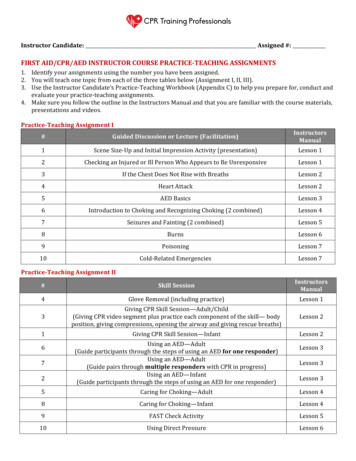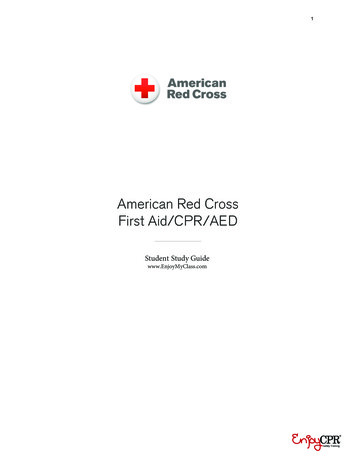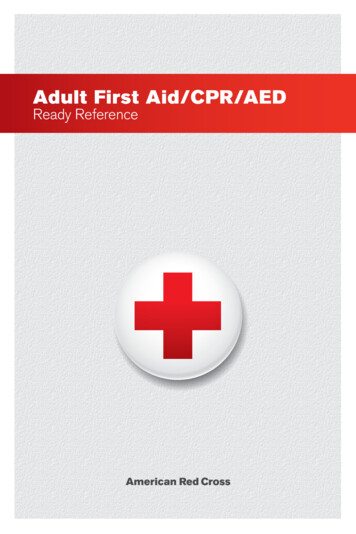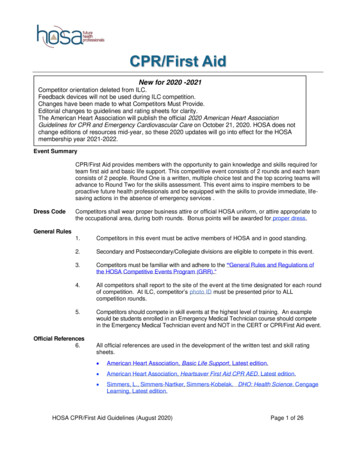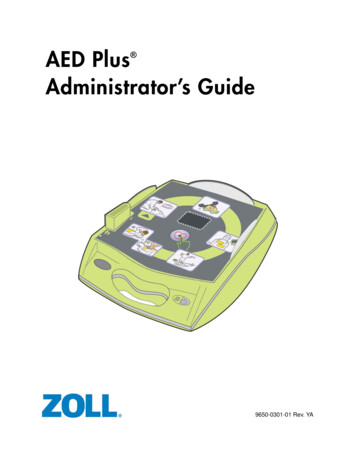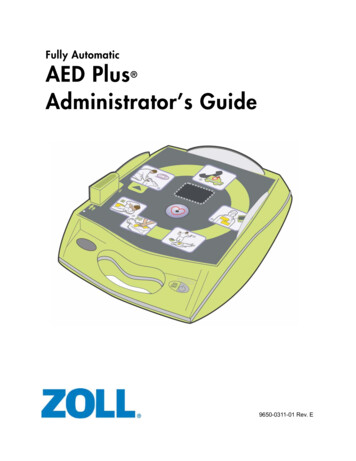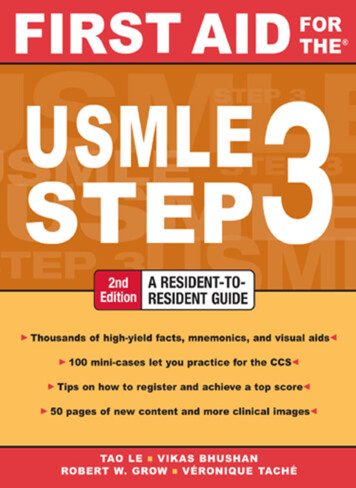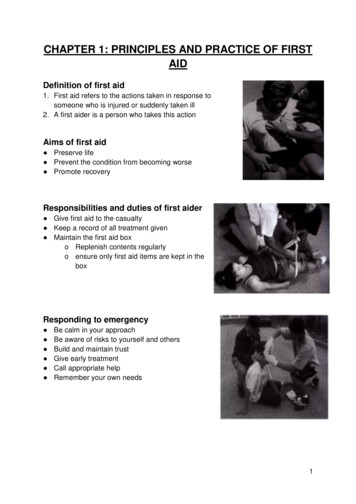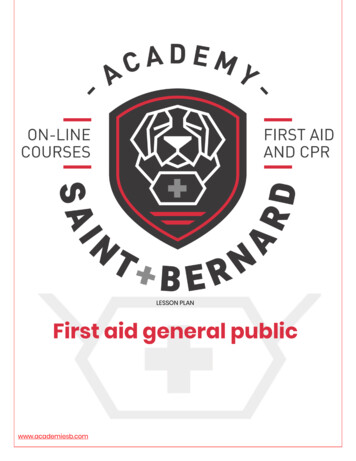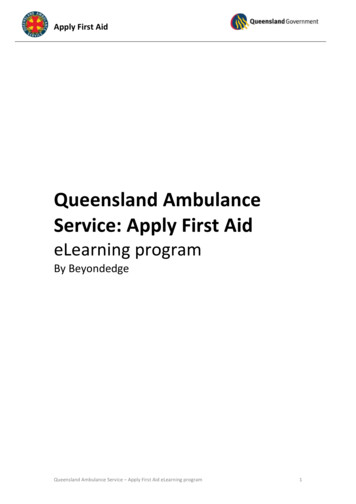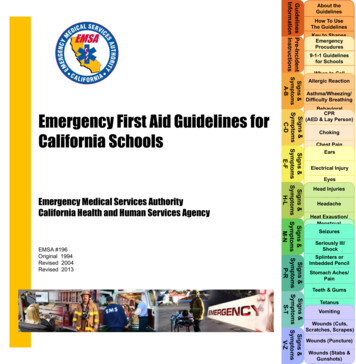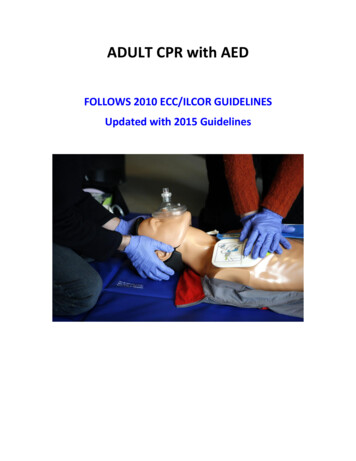
Transcription
ADULT CPR with AEDFOLLOWS 2010 ECC/ILCOR GUIDELINESUpdated with 2015 Guidelines
Welcome!We’re excited that you’ve decided to take CPR, and that you’ve chosen us todirect your learning experience.Despite technological advances and new scientific discoveries, heart diseaseremains the number one cause of death globally, with 17.3 million deaths peryear; 38.7% of cases of out of hospital cardiac arrests (OHCA) are witnessed by abystander (AHA, 2015). Learning CPR can save lives- you can save a life.In this course, you will learn: The Chain of Survival and your place within the chainHow to provide high quality chest compressions for adultsHow to initiate early use of an AED (automated external defibrillator)How to provide rescue breathing for victims of respiratory arrestHow to provide CPR with 2 rescuersHow to assist adult victims of chokingLet’s get started!
The Five FearsMany bystanders are reluctant to perform CPR. There are many reasons why bystanders arereluctant to get involved. Let’s take a look at some of these reasons so that you can understandwhy they have no real basis of support.Fear of Disease: Use universal precautions when the possibility exists of coming into contactwith bodily fluids. Use gloves, mask, and/or gown when you have them available. The benefit ofinitiating lifesaving resuscitation in a patient in cardiopulmonary arrest greatly outweighs therisk for secondary infection in the rescuer or the patient. Nevertheless, use of simple infectioncontrol measures during CPR and CPR training can reduce a very low level of risk even further(Mejicano & Maki, 1998).Fear of Lawsuits: These laws state that a person acting in good faith who is renderingreasonable first aid will not be held accountable for damages to the person to whom the aid isrendered, unless gross and willful misconduct are involved. Good Samaritan laws may differ forprofessional health care providers versus lay rescuers from state to state. Implied consentmeans that there is an assumption that if an unconscious person were able to request care,they would do so.
Fear of Uncertainty: People sometimes fear that they won’t remember what to do.Remembering the correct number of compressions or the number of compressions toventilations is not as important as the willingness to respond and to push hard and fast. Handsonly CPR is designed to provide simple life support. No mask, no worry- performingcompressions alone has been shown to be effective at saving lives.Fear of Harming the Victim: A victim in need or clinically dead can only be helped by yourintervention efforts. You can’t hurt someone who is dead, and any injuries you mayunknowingly cause (such as injured ribs) can be dealt with in a surviving victim of cardiac arrest.
Fear of Injury to Self: As you will learn, scene safety is of utmost importance, and checking thescene for safety should be your first action when you come across an unconscious victim. If thescene is not safe for you to enter, you must not enter. This will only result in more victims.Under no circumstances should you risk becoming a victim. Instead, you should call for help(activate EMS).
BASIC ANATOMY AND PHYSIOLOGYBefore you learn how to perform CPR, it’s important to understand how the heart, lungs, brainand cells perform. Here is a brief review of these systems.THE HEARTThe heart consists of four chambers, the right and left atria (singular: atrium) and the right andleft ventricles. The atria are located above the ventricles, as can be seen in the above diagram.The heart is a muscular organ supplied by the coronary arteries. It is located below yourbreastbone (sternum) and, in an adult, is approximately the size of your fist.The heart pumps blood that has been deoxygenated after supplying the body’s tissues into thelungs, and when that blood has been oxygenated again in the lungs, it exits the lungs to the left
side of the heart, where it is pumped out into the body once again, to provide oxygen to thevital organs.Your body has about 5 liters of blood, which circulate through this system approximately 3times per minute.What is known as the cardiovascular system is composed of the heart, arteries, capillaries, andveins.THE LUNGSYour lungs are spongy, air-filled sacs, with one lung located on either side of the chest. Thetrachea, which is sometimes called the windpipe, conducts air down into the lungs through the
bronchi, which are smaller tubular branches. The bronchi then divide into smaller and smallertubules called bronchioles. Air is exchanged in the alveoli, which are tiny sacs that allow oxygenand carbon dioxide to move between the lungs and the bloodstream via tiny capillaries.Your lungs take in oxygen to supply your body’s organs and tissues. They release carbondioxide, a waste product, into the atmosphere when you exhale.Room air at regular atmospheric pressure contains 21% oxygen. Our bodies utilizeapproximately 4-6% of that oxygen and release about 16-17% back into the atmosphere, alongwith carbon dioxide, when we exhale. This 16-17% that we exhale can provide just enoughoxygen to sustain someone in cardiac arrest, at least for a short time.THE BRAINYour brain needs a constant supply of oxygen. Without oxygen, brain cells begin to die in 4 to 6minutes.On average, the brain weighs three pounds, and uses a whopping 20% of the body’s oxygen!The medulla is located in the brain stem and controls automatic bodily functions, includingconsciousness and respiratory and cardiovascular function.
THE BODY’S CELLSAll of the body’s tissues are made up of cells.All cells require oxygen to carry out their normal functions. They also require nutrients. Oxygendeprivation, or hypoxia, will cause cells to die within a few short minutes.The body’s cells use oxygen and produce carbon dioxide as a waste product. Carbon dioxidemust be eliminated via the lungs through ventilation.Red blood cells transport oxygen throughout the body.
CARDIOVASCULAR DISEASEAs mentioned previously, cardiovascular disease is the number one cause of death worldwide.While it is important to learn what to do when cardiovascular disease leads to a heart attack orstroke, it is equally as important, if not more so, to understand how to prevent cardiovasculardisease from occurring in the first place.There are numerous factors that can increase an individual’s risk of heart attack. Some of thesefactors can be controlled (modifiable risk factors), while others cannot (non-modifiable riskfactors.Modifiable risk factors, or factors that can be controlled to a certain degree by an individual,include: cigarette smokinghypertensionobesitysedentary lifestyle (lack of exercise)high cholesterolhigh blood sugar (in diabetes)poor diet (diet high in sugar, fat)stressNon-modifiable risk factors, or risk factors that individuals cannot change, include: agesexgenetics/hereditary factors (i.e. hereditary high cholesterol or hyperlipidemia)race (i.e., certain groups may be at higher risk for hypertension, or high blood pressure)CARDIOVASCULAR DISEASE IS THE NUMBER ONE CAUSE OF DEATH IN THE UNITED STATES,ACCORDING TO THE CENTER FOR DISEASE CONTROL (CDC). THE CDC ESTIMATES THAT MORETHAN 650,000 AMERICANS DIE FROM CARDIOVASCULAR DISEASE (1 in 4 DEATHS) EACH YEARIN THE UNITED STATES.Cardiovascular disease damages the heart and blood vessels, and frequently causes heartattack and/or stroke. Americans of all ages should focus on prevention of cardiovasculardisease by eating healthy foods, exercising 30 minutes (at least) each day, controlling weight,minimizing stress, consuming healthy fats and oils, and avoiding cigarette or cigar smoking.
Atherosclerosis, or hardening of the arteries, is a condition caused by the building up of plaqueinside the body’s arteries, the large blood vessels that carry blood away from the heart to thebody’s organs. Plaque is composed of fatty substances, cholesterol, fibrin (a clotting substancein the blood), calcium and cellular waste products. When plaque builds up, it can partially ortotally block the flow of blood through an artery in the brain (which causes stroke), the heart(which causes a heart attack), the kidneys, the arms, the legs and other vital areas. Plaque maybreak off to block an artery, or a blood clot (thrombus) may form on the surface of the plaqueeither of these two circumstances can lead to a heart attack or stroke.
HEART ATTACKA heart attack often presents with one or more of the following symptoms: Chest tightness, pressure, or discomfortNauseaSweatingShortness of breathFatigueWeaknessPain in the jaw or armPallor (pale color of the skin)Women and people with diabetes often present with atypical symptoms, such as nausea andvomiting or back pain. About one-third of patients report no chest pain at all.WHAT CAN YOU DO? Recognize the symptoms and signs of a heart attack.Call 911.Don’t let the patient drive him or herself to the hospitalKeep the patient calm and seated in a position that is comfortable.Offer 1 adult aspirin or 2 baby aspirin- aspirin should be chewed before swallowing tospeed absorption (Note: do not give if the patient has already taken aspirin or if thepatient has an allergy to aspirin)Be prepared to start CPR if it becomes necessary
STROKEYou should suspect stroke if a patient or victim presents with: Severe headache with no known causeNumbness or weakness of the face, arm or leg on one side of the bodyDrooping eyelid or mouth on one sideConfusion or trouble understandingDifficulty speaking (slurred speech or difficulty finding words)Loss of balance or coordinationDizzinessTrouble with vision (i.e. blurred or double vision, loss of vision in one eye)WHAT CAN YOU DO? Know the signs and symptoms of a strokeCall 911Don’t give the patient food or drinkKeep the patient calm and quietMonitor the patientBe prepared to begin CPR if it becomes necessaryA stroke is caused by one of two mechanisms: it can be caused by a ruptured blood vessel inthe brain (called a hemorrhagic stroke) or by a blockage in one of the arteries that causes lossof blood flow and oxygen to a part of the brain (called an ischemic stroke). Ischemic strokes aremore common. Remember that “Time is brain,” and act quickly. Stroke is the 3 rd leading causeof death in the United States.
Guideline ChangesFor anyone who has taken CPR prior to 2010, there have been a few key changes since the 2010Guidelines were instituted. These changes include: Changing from the ABCs (Airway-Breathing-Circulation) to a C-A-B sequence of steps.This was one of the major changes that took place in 2010, when research showed thatdecreasing the delay in beginning chest compressions lead to a higher incidence of ROSC(return of spontaneous circulation). Rescuers are now trained to provide interventionsin the following order: 1) Chest Compressions, 2) Airway, and 3) Breathing. Decreasingthe delay in beginning compressions increases survival rates.The removal of “Look, listen and feel” for breathing. It is often hard for even trainedproviders to identify effective breathing. It is no longer recommended to look, listenand feel to determine whether a victim is breathing. Rather, if the victim is notresponsive, has no pulse, and is not breathing or is breathing in an irregular fashion (i.e.only gasping), begin CPR immediately!Emphasis on high-quality CPR. High-quality CPR is defined as:o Compression rate of 100- 120 beats per minute on victims of all ages;o Compression depth of AT LEAST 2 inches in adults (but no greater than 2.4inches). Allow the chest to completely expand (recoil) after each compression(do not lean on the chest between compressions);o Not interrupting CPR except to use an AED (keep interruptions in chestcompressions to less than 10 seconds);o Avoiding excessive ventilations;o Above all else, PUSH HARD AND FAST!Since many responders (even professionals) are unable to feel or palpate a pulsequickly, the recommendation is to feel for a pulse for NO MORE THAN 10 seconds. If youcan’t feel a pulse or if you’re not sure you can feel a pulse, begin CPR.It has been recognized that health care professionals should call for assistance whenthey come upon an unconscious victim, but they may also simultaneously assessbreathing and check for a pulse before fully activating the emergency response system.This may encourage efficiency in assessment and response, rather than following a stepby-step response.Health care professionals may tailor their response to an unconscious victim by alteringthe response sequence to fit the situation or scenario (using an AED immediately whenone is close by and the arrest is witnessed, or providing ventilations first when the causeof arrest is known to be an anoxic event (i.e. drowning).
Rescuers should provide 1 breath every 6 seconds when an advanced airway is in placeand compressions are ongoing continuously (rather than trying to remember a range ofventilations for adults, children and infants).
The Adult Chain of SurvivalThe Adult Chain of Survival represents a continuum of care, from early recognition of the victimin cardiac arrest to post-resuscitation care to provide the best chance of survival from cardiacarrest. The five links in the Adult Chain of Survival include: Early recognition of cardiac arrestActivation of the Emergency Response SystemEarly CPR, with an emphasis on high-quality chest compressionsEarly defibrillationComprehensive post- cardiac arrest careNote that in the diagram above, the first two of the five steps (early recognition of cardiacarrest and activation of the emergency response system) have been combined to acknowledgethe fact that these steps often occur simultaneously when multiple rescuers are present.
THE TEAM APPROACHIn many situations, there may be only one rescuer who will carry out the normal sequence ofassessments and actions. However, in many situations, there is often more than one rescuertrained and willing to help.This is when a team approach can be used. The first rescuer should take the role of team leaderand delegate tasks. One rescuer can provide compressions, one can prepare to give breathswith a bag-valve mask, and one can prepare the AED. By working together, the most efficientcare can be given to the patient.Chest Compressions for AdultsChest compressions are the most important component of CPR. Chest compressions are anattempt to mimic the normal activity of the heart. When a rescuer presses down on a victim’schest, blood is forced out of the heart and into the arteries. When pressure on the chest isreleased, blood is allowed to return to the heart. A small amount of oxygen will be present inthe bloodstream for several minutes after the heart ceases to beat, just enough to keep thebrain alive. Compressions can keep vital organs functioning until higher level care is available.Adult Chest Compressions
To perform compressions on an adult, placethe heel of your non-dominant hand on thevictim’s chest between the nipples. Thenplace your other hand on top of the first andinterlace your fingers. The heel of your handshould be pressing on the bottom two-thirdsof the sternum, avoiding the xiphoid process(the small bony prominence at the verybottom of the sternum (breastbone). Youshould be as close to the victim’s side aspossible, with your knees against thevictim’s side (this will help prevent backinjury). Lock your elbows and press downhard, depressing the sternum at least 2inches (5 cm), but no more than 2.4 inches(6 cm). Your shoulders should be positioneddirectly over your hands in a straight line.Push hard and fast 100 to 120 times perminute, counting out loud as you do so. It’simportant that you allow the chest to recoil(return to it’s normal, relaxed position) inbetween compressions. If you do not allowthe chest to recoil, the heart will not fillcompletely, which means that less blood(and therefore oxygen) will be pumped outof the heart to vital organs with the nextcompression.Performing compressions is exhausting.Most people find that they become verytired after providing compressions for 2 or 3minutes. When a person performingcompressions becomes fatigued, there is atendency to compress less firmly and moreslowly; for this reason, it is recommended that rescuers trade off doing compressions every 2minutes to prevent fatigue and optimize the quality of compressions. If you are alone, you willhave to do the best you can- keep performing compressions until help arrives or you arephysically so exhausted that you cannot continue.
One Rescuer Adult CPRIf you are alone and come across an individual who is down, follow the steps below. If someoneelse is in the area to assist, use the ‘Two Rescuer’ sequence.Stay Safe: If you come upon an individual who may need CPR, look around and make sure youand the victim are in a safe place. For example, if the victim is in water or on a road, try to movethe victim to a safer area. If you are in a safe area, do not try to move the victim as he/she mayhave other injuries (i.e., to the head or neck) that you cannot see. Simply roll him over onto hisback. Make sure the victim is on a firm surface, in case compressions are needed.Assess the Victim: To quickly assess the victim, shake his shoulder and yell at him. Check forbreathing. If he/she is not breathing, or is not breathing normally (i.e., only gasping), you mustsummon help. Note: Agonal breathing is breathing that is very slow, shallow and/or gasping.Agonal breathing is a sign that the victim is dying. It is important not to mistake agonalbreathing for normal breathing!Activate the Emergency Response System and Find an AED: Yell for help. If someone responds,tell him/her to call for help by dialing 9-1-1. If you are in an area where an AED may beavailable, tell him to go find the AED. Make sure you tell the person to return to assist you assoon as possible. If you are alone, call for help by dialing 9-1-1 and run to get the AED if youknow where one is nearby. If you do not know where an AED is, begin CPR immediately aftercalling for help. Mobile phones have made activating the emergency response system mucheasier- you can call 9-1-1 and put your phone on speaker while you start CPR.Begin CPR1. Check for a pulse on the side of the neck. Feel for a pulse for at least 5 seconds but NOMORE THAN 10 seconds. To check for a carotid pulse, slide 2 or 3 fingers into the groovebetween the windpipe and the neck muscles at the side of the neck.2. If there is no pulse (or if you are unsure if there is a pulse), begin CPR starting with chestcompressions. Provide 30 chest compressions, followed by two breaths. NOTE: If youare not comfortable giving rescue breathing and/or you do not have a mask available,do ‘Compression Only’ CPR.a. Use the heel of one hand on the lower half of the breastbone in the middle ofthe chest.b. Place the other hand on top of the first hand.c. Straighten your arms and lock your elbows so that your body weight is over yourhands.
d. The most important part of CPR is to remember to push HARD and FAST. Eachcompression should be AT LEAST two inches deep (but no more than 2.4 inches)and the rate should be 100-120 compressions per minute.e. Be sure to let up on the pressure on the sternum after each compression (chestrecoil) so the chest can re-expand and blood can flow back into the heart. Thepurpose of CPR is to help the blood flow through the heart and into the rest ofthe vital organs; if you allow the chest to re-expand, more blood will flow intothe heart and will be available to deliver to the rest of the body.f. Count out loud as you do compressions. When you have done 30 compressions,try to open the victim’s airway by doing a head tilt/chin lift. Note that if you aredoing ‘Compressions Only’ CPR, you can skip this step.i. With your non-dominant hand, push on the victim’s forehead to tilt thehead back.ii. With your dominant hand, place your fingers under the bony part of thelower jaw and gently lift the jaw to bring the chin forward. Be sure youlift up on the bony part of the jaw and not the soft tissue under the jawso you don’t block the victim’s airway. Do not use your thumb to lift thejaw. Allow the victim’s mouth to remain slightly open.iii. If you think the person’s neck may be injured, avoid the head tilt/chinlift. Use the jaw thrust maneuver if you have been trained to do so.g. If you have a barrier device to use between your mouth and the victim’s face,use it. Although the risk of infection from performing CPR is very, very low, it isexpected that healthcare workers use a barrier device when providing CPR. Thisincludes the use of face masks or bag-mask devices (see next section). Give eachbreath slowly – each breath should last one second. Make sure the chest riseswith each breath. Repeat, giving a second breath.h. Start another cycle of chest compressions. Remember, push HARD and FAST.Alternate chest compressions (30) and giving breaths (2) until help arrives.
Airway/ BreathingFace masks provide a barrier between the rescuer and the victim. Some masks are equippedwith a one-way valve that allows the rescuer’s breaths to enter the victim’s airway, butprevents the victim’s expired air from entering the rescuer’s airway. These masks also preventcontact with vomitus and blood, which could pose an infection risk to the rescuer. It takespractice to learn how to use these masks effectively to provide ventilations.Using a Face Mask:a) Position yourself at the victim’s side. If you are a lone (single) rescuer, positioningyourself at the victim’s side will allow you to provide both ventilations and compressionswithout having to move.b) Position the mask on the victim’s face. Masks are usually triangular in shape, and youwill notice that the mask has a “pointy” end- this end goes over the bridge of thevictim’s nose.c) Seal the mask against the victim’s face. To do this, take the hand that is closest to thetop of the victim’s head and place it along the edge of the mask. Some people find iteasier to form a ‘C’ with their index finger and thumb and use these digits to grasp themask around the base of the mouthpiece. With the thumb of your other hand, applypressure along the bottom edge of the mask. Then place the remaining fingers of yoursecond hand along the bony edge of the jaw and lift the jaw upwards. Open the airwayby performing a head-tilt chin-lift procedure. While you lift the jaw, ensure that you aresealing the mask all the way around the outside edge of the mask to obtain a good sealagainst the victim’s face.d) Deliver air over 1 second, ensuring that the victim’s chest rises.e) If the victim’s chest does not rise, reposition the mask and try to get a better seal.Remember, you should be lifting the victim’s jaw into the mask, rather than simplypushing the mask down onto the victim’s face.f) Provide 2 ventilations over 1 second each with the mask after every 30 compressions.g) If the victim has a pulse but is not breathing, provide rescue breathing by providing 1breath every 5 to 6 seconds (10-12 breaths/minute). Check for a pulse every 2 minutesif there is no pulse, start chest compressions along with ventilations at a rate of 30:2.
Using a Bag-Mask Device:A bag-mask device (or BVM, bag-valve mask) consists of a mask attached to a reservoir bag.They are commonly used to provide positive-pressure ventilations during CPR. They can beattached to an oxygen source to provide 100% oxygenation during resuscitation. As with theface mask, it takes practice to be able to use a bag-mask device. It can also be very difficult forone person to use a bag-mask device; therefore, it is recommended that use of a bag-maskdevice be used only when there are two rescuers available.The steps to using a bag-mask device are as follows:a) Position yourself at the top of the victim’s head- this allows room for the second rescuerto provide compressions.b) Place the mask of the bag-mask device on the victim’s face, using the bridge of thepatient’s nose as a guide to correct positioning.c) Use the E-C clamp technique to hold the mask in the correct position while you lift thejaw to obtain an open airway. To perform the E-C clamp technique, take the index fingerand thumb of your non-dominant hand and form them into a ‘C’ around the top of themask. Your other fingers of the same hand are used to lift the jaw (the ‘E’ part of the E-Cclamp technique.d) Squeeze the bag to deliver a breath- each breath should be delivered over 1 second.Watch for chest rise. If you do not observe chest rise, you do not have a tight seal. If thisoccurs, reposition the mask and try again. Be careful not to overinflate the lungs- eachbreath should result in visible and natural chest rise.e) Provide 2 ventilations after every 30 compressions. If the patient has a pulse but is notbreathing, provide one breath every 5-6 seconds (10-12 breaths/minute) and check for a
pulse every 2 minutes. If the victim loses their pulse, you will need to begin chestcompressions.The Jaw Thrust ManeuverIf you suspect that a victim may have a neck or spinal cord injury (i.e., the victim has fallen,been in a motor vehicle accident or suffered another mechanism of injury that could result ininjury to the neck or spinal cord), you should not use the head tilt-chin lift maneuver to openthe victim’s airway. This could further damage the neck or spinal cord. Instead, you should usethe jaw thrust maneuver to open and maintain the victim’s airway.To perform this maneuver:a) Place your hands on either side of the victim’s head. Rest your elbows on the surfacethat the victim is laying on.b) Put the fingers of both your hands under the angle of the victim’s lower jaw and lift sothat the jaw slides forward.c) Use your thumb to push the lower lip away from you if the victim’s lips close.
Two Rescuer Adult CPR (without an AED)If you come across a victim who is down and another person is available to help, send thatperson to activate the Emergency Response System and find an AED while you assess whetherthe victim needs CPR. When you have determined that the victim requires CPR, start CPRbeginning with compressions. When the second person returns (without an AED in this case): You should continue chest compressions and count the compressions aloud each timeyou compress the victim’s chest.The second rescuer should keep the person’s airway open using the head tilt-chin liftmaneuver. The second rescuer should give two rescue breaths after every 30compressions, using a face mask or a bag-mask device.You and the second rescuer should switch positions/roles about every two minutes soneither one of you gets tired. If you are counting out loud, two minutes is about 5cycles of thirty compressions and two breaths. You should change positions sooner ifthe person doing compressions becomes too tired to perform high-qualitycompressions.Continue switching roles as above until EMS arrives to relieve you or the victim regainsconsciousness.
Using an AEDAn AED, or automated external defibrillator, is a device that has the ability to detect and treat,through electrical energy, the lethal arrhythmias known as ventricular fibrillation andventricular tachycardia. These rhythms are a common cause of sudden cardiac arrest.Ventricular fibrillation is a condition in which the lower chambers of the heart, the ventricles,quiver in an unorganized fashion, which renders them incapable of pumping blood to the restof the body. Untreated, ventricular fibrillation rapidly causes cardiac arrest. Ventriculartachycardia is a rapid rhythm also originating in the ventricles. In ventricular tachycardia, theventricles contract so quickly, albeit in a somewhat organized fashion, that inadequate bloodflow is produced. Ventricular tachycardia often precedes ventricular fibrillation. Both rhythmsare lethal if not treated.An AED sends electrical energy (a ‘shock’) through the heart, which stuns the heart and allowsthe normal pacemaker of the heart, usually located in the right atrium, to take over and restorea normal heart rhythm.
Early defibrillation is key to survival in cardiac arrest. For each minute that defibrillation isdelayed, the chance of survival is reduced by 10%. (after 10 minutes, few people aresuccessfully resuscitated.)Early defibrillation can increase survival rates to greater than 50%. Rescuers shouldimmediately begin chest compressions, and use the AED as soon as it is available and ready touse.AEDs can be found wherever crowds of people gather- swimming pools, airports, malls,sporting arenas, schools, hotels More and more businesses are also investing in these lifesaving machines. In some communities, private AED owners are registering their AEDs withambulance dispatch, so that they can be easily located by bystanders when needed. Make it apoint to learn where the AEDs in your neighborhood or town are located- you never knowwhen you might need one!AEDs have been designed to be extremely “user friendly”. All you need to do as a rescuer is turnon the machine (the most important step) and listen as the machine guides you through thesteps to use the AED safely and effectively. Although there are many brands of AEDs on themarket, they all work in a similar fashion and are designed to be used by lay rescuers.
When an AED becomes available (i.e., when you or another rescuer have retrieved it), place itat the victim’s side, closest to the rescuer who will operate it. In this way, the other rescuer cancontinue performing CPR until the AED is ready to analyze and deliver a shock (if needed).There are four universal steps to using any AED. These will be highlighted in the following list ofsteps so they are easily recognizable.The steps to use an AED are as follows:1. Turn on the machine. This is the most important step- turning on the machine willenable the AED unit to guide you through the next steps. To turn on the AED, open thetop of the carrying case an
reasonable first aid will not be held accountable for damages to the person to whom the aid is rendered, unless gross and willful misconduct are involved. Good Samaritan laws may differ for professional health care providers
